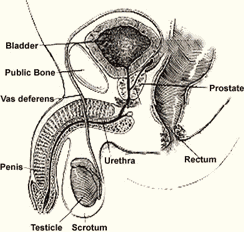|

MALE EXTERNAL GENITALIA
| The penis | The glans | The
corona | The frenulum | The prepuce |
| The urethral meatus | The smegma | The
scrotum |
Parts of the penis and scrotum

- The Penis
The shaft of the penis is formed by three columns of erectile tissue full of blood
vessels, bound together by fibrous tissue. At the end of penis is the cone-shaped glans.
- The glans
The glans is the head of the penis. Prepuce usually covers the glans. The glans, as
well as the corona - the ridge of flesh that connects the glans to the shaft of the
penis - is highly sensitive.
- The corona
The 'crown' a ridge of flesh denoting the junction of head of the penis with the
shaft.
- The frenulum
A thin strip of flesh on the underside of the penis that connects the shaft to the
head.
- The prepuce (foreskin)
In uncircumcised males, the glans is covered by a loose, hood-like foreskin called the
prepuce, which rolls over and covers the head of the penis. Prepuce is what is removed
during circumcision.
- The urethral meatus
The opening at the tip of the penis to allow the passage of both urine and semen.
- The smegma
A cheese like substance secreted by glands on each side of the frenulum in
uncircumcised men.
- The scrotum
The scrotum is loose, wrinkled pouch of skin that hangs behind and below the penis, divided into two compartments, each of which contains a testicle. The scrotum is a sac, and contains the testes, the male sexual glands. The scrotum's primary function is to
maintain the testes at approximately 34º C, ideal temperature for testes to produce sperm
effectively.
Internal Anatomy
|